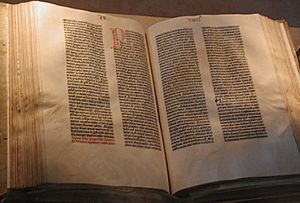2nd millennium facts for kids
| Millennia: | 1st millennium · 2nd millennium · 3rd millennium |
| Centuries: | 11th century · 12th century · 13th century · 14th century · 15th century · 16th century · 17th century · 18th century · 19th century · 20th century |
The 2nd millennium was a long period of time that started on January 1, 1001, and ended on December 31, 2000. It lasted for 1,000 years. During this millennium, the world changed a lot. People made many new discoveries and inventions. Societies grew and developed in amazing ways.
Contents
What Was the 2nd Millennium?
The 2nd millennium saw huge changes across the globe. It began after the first 1,000 years of the Common Era. It ended just before the 21st century began. This period included many important historical events. These events shaped the world we live in today.
The Middle Ages (1001-1400s)
The first part of the 2nd millennium was still part of the Middle Ages. This time was also called the Medieval period. In Europe, powerful kings and queens ruled. Knights were important figures. Most people lived in small farming villages.
Life in Medieval Times
Life was often hard for ordinary people. They worked on farms and had simple tools. Castles were built for protection. Churches were very important centers of community life. New cities slowly started to grow.
New Ideas and Learning
Even in the Middle Ages, new ideas were forming. Universities began to appear in Europe. Scholars studied old texts and new ideas. Important inventions like the windmill helped with work. The compass made travel easier.
The Renaissance and Exploration (1400s-1600s)
After the Middle Ages came the Renaissance. This word means "rebirth." It was a time of great art, science, and learning. People became very interested in ancient Greek and Roman ideas.
Amazing Art and Science
Artists like Leonardo da Vinci and Michelangelo created famous works. Scientists like Nicolaus Copernicus changed how people saw the universe. They showed that the Earth orbits the Sun. This was a big new idea.
Exploring the World
This period also saw the Age of Discovery. Brave explorers sailed across oceans. They found new lands and trade routes. Christopher Columbus reached the Americas in 1492. This connected different parts of the world. New goods and ideas were exchanged.
The Printing Press
A very important invention was the printing press. Johannes Gutenberg developed it around 1440. Books could now be made much faster and cheaper. This helped spread knowledge and new ideas widely. More people learned to read.
The Age of Revolutions (1700s-1800s)
The 18th and 19th centuries brought many revolutions. These were big changes in how people lived and were governed.
Big Changes in How We Live
The Industrial Revolution started in the 1700s. New machines were invented. Factories were built. People moved from farms to cities to work. This changed how goods were made. It also changed how people lived their daily lives. Steam power and new technologies made travel faster.
New Ways to Govern
Political revolutions also happened. The American Revolution (1775-1783) led to the creation of the United States. The French Revolution (1789-1799) changed France. These revolutions promoted ideas of freedom and rights. They inspired people around the world.
The 20th Century (1900s)
The last 100 years of the 2nd millennium were the 20th century. This was a time of rapid change. It saw huge advancements in technology and science.
World Wars and New Technology
Sadly, the 20th century also had two major global conflicts. These were World War I and World War II. These wars involved many countries. They led to new ways of thinking about peace and cooperation. After the wars, technology grew even faster.
Space Exploration and Computers
Humans achieved amazing things. We learned to fly airplanes. We even went to the Moon! The Space Race was an exciting time. Computers were invented. They became smaller and more powerful. This led to the Internet and the digital age. These inventions changed how we communicate. They also changed how we learn and work.
Global Connections
By the end of the 2nd millennium, the world was more connected than ever. Telephones, television, and the internet linked people globally. This made it easier to share information and cultures. It also created new challenges and opportunities for everyone.
See also
In Spanish: II milenio para niños


